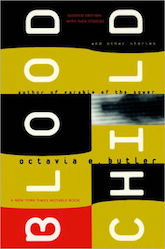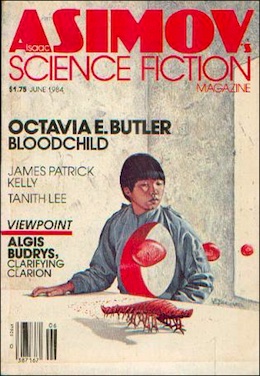In 2016, Fantastic Stories of the Imagination published my survey “A Crash Course in the History of Black Science Fiction.” Since then Tor.com has published nineteen in-depth essays I wrote about some of the 42 works mentioned, and a twentieth essay by LaShawn Wanak on my collection Filter House. Finally, halfway through the series, in this twenty-first column, I explore the work of our official genius, Octavia Estelle Butler. Later we’ll get into her novels, the form for which she’s best known. Let’s start, though, with “Bloodchild,” a short story which won her both the Hugo and Nebula Awards.
INVASION OF THE INCUBATORS
Butler’s “Bloodchild” protagonist, Gan, is born on a planet colonized by humans and home to a species of giant, sentient centipedes. When the humans first arrived neither race recognized the other as intelligent, but by the time the story begins a tense truce has been negotiated. Humans live on special preserves, and each family “voluntarily” commits one male child per generation to incubating the centipedes’ offspring. Usually the grubs which hatch from eggs laid in these men’s bodies are removed before they devour them from the inside out. Unfortunately, young Gan encounters a man whose centipede is absent, and who is therefore experiencing the horror of a hatching without her surgical intervention or the tailored pain relief drugs only she can provide.
Humans are the aliens in this scenario. And challenging the popular science fiction narrative which reenacts white imperialism by mapping the subjugation of non-European lands onto the conquest of extraterrestrial space, it is the foreign humans, rather than the natives, who are reduced to the status of a commodity.
SLAVES TO THE RHYTHM METHOD
That the commodity humans represent is a highly valued one doesn’t really matter. That the long-term success of the centipedes’ reproduction cycle is dependent on them means that they’re coveted and protected, not that they have much choice as to whether or not they’re impregnated.
Despite the many parallels to slavery that critics pointed out to her in her story, Butler was always adamant that the real inspiration for “Bloodchild” lay in the politics of sex. Consent and bodily boundaries are often troublous in Butler’s work. In this story as in many others, constraint is a factor in supposedly consensual agreements. Like women in patriarchal societies coupling with men, the human families must come to accept their selection by centipedes endowed with power and privilege. Then they carefully decide which family member will render services; it’s almost always a male, in order to ensure that human reproduction is less impacted by the incubation process.
Relationships between unequals can never be purely consensual; they’re built on imbalance. The humans in “Bloodchild” risk annihilation. A scenario in which psychoactive chemicals and imprisonment accomplish the centipedes’ goals sans human agency lies in the story’s very recent past. Suicide is another option Gan seriously considers. Love such as he feels for the centipede who has befriended his family can function as weapon, or a cage, circumscribing movement away from its problematic focus. But as “Bloodchild” ends we know that Gan, at least, is willing to keep dancing this awkward dance.
AIN’T I A WOMAN?
The pressure to classify this story as an allegory of slavery comes on multiple fronts. That Butler resisted doing so shows how stubborn she could be when it came to sticking to her aesthetic principles. Framing the proposition as either/or, though, is a failure of understanding. People can claim multiple identities and multiple oppressions, and these often inform our creative work. Butler was black and a woman and tall and shy and nearsighted and a vegetarian and an atheist and a high blood pressure patient. Three of these identities divided her from this culture’s default settings in ways the culture calls important: race, gender, and religion. Viewing “Bloodchildren” through at least two identity lenses—race and gender—produces binocular vision. Depth. Room to wander around in the world the author made.
IF YOU LIVED HERE YOU’D BE HOME BY NOW
Per its proponent Darko Suvin, cognitive estrangement is science fiction’s tool for getting readers to recognize truths they’d otherwise be averse to. By locating her story on a distant planet, in the future, Butler made the unpalatable so fresh, so unfamiliar, that it could be swallowed whole and mentally digested later. Not a “spoonful of sugar,” but a place setting of utensils wrought of finest unobtainium. The terrifying, choice-poor path lying before Gan is one many marginalized readers know well, while this society’s giant centipedes may find it so mundane as to be beneath their ordinary notice.
Buy the Book


Bloodchild And Other Stories
IMMORTAL LACKS
Butler urged students to write about what they feared. What did she fear? Parasitic insects appear repeatedly in her work—though only in “Bloodchild” do they argue their own case. Loss of autonomy features frequently as well—as in her breakout novel Kindred and her made-for-sequels last book, Fledgling. The beauty of her treatment of these themes is how she transforms such horrors into achingly involving, deeply compelling calls for autonomy, freedom, and bodily integrity.
BECAUSE THEY CAN
Beyond the coercion implicit in his people’s situation, Gan’s motivation for allowing himself to be impregnated is twofold: he loves and wishes to protect his sister Hoa, the family’s other candidate for hosting the natives’ living larvae; and he loves and wishes to please his family’s giant centipede, T’Gatoi. For centuries women have weighed the dangers of childbirth against its rewards. With her story of a man dealing in similar complexities, Butler strikes a rich and reverberating chord, one that echoes through multiple identities, multiple dynamics, multiple contingencies. “Bloodchild” is a glorious accomplishment—an elegant, urgent tale that changes all who read it. Perhaps that’s because it’s also a lasting and faithful depiction of what we can and will do to survive.
 Nisi Shawl is a writer of science fiction and fantasy short stories and a journalist. She is the author of Everfair (Tor Books) and co-author (with Cynthia Ward) of Writing the Other: Bridging Cultural Differences for Successful Fiction. Her short stories have appeared in Asimov’s SF Magazine, Strange Horizons, and numerous other magazines and anthologies.
Nisi Shawl is a writer of science fiction and fantasy short stories and a journalist. She is the author of Everfair (Tor Books) and co-author (with Cynthia Ward) of Writing the Other: Bridging Cultural Differences for Successful Fiction. Her short stories have appeared in Asimov’s SF Magazine, Strange Horizons, and numerous other magazines and anthologies.










